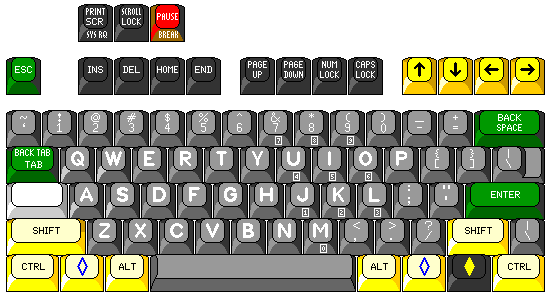
An arrangement like the one below:

which makes only two minimal adjustments to the contemporary version (including Windows keys) of the main typing area - adding the extra international key to the right of the right shift key, and repurposing Caps Lock - would be more likely to enjoy general success than one which, like some examples on the previous page, attempts to significantly change the main typing area in order to have the large Enter key characteristic of many electric typewriters.
Making the keyboard higher by a vertical row simply for Print Screen, Scroll Lock, and Pause, rather than just using smaller keys, may be considered peculiar, of course. The extra space in the top row can be used for the Num Lock/Caps Lock/Scroll Lock lights, and for ACPI keys (Power, Sleep, Wake), though.
Since the function keys are not frequently used in the current GUI environment, the idea is that the keys from Insert to the cursor keys are laid out in the spaces the function keys occupied so as to be able to be used for that purpose (with the key in the old Caps Lock position serving as an Fn key). The fact that the Macintosh uses Print Screen, Scroll Lock, and Pause as F13, F14, and F15 is also acknowledged by the design.
One weakness, though, is that if the Fn key is also used to shift other keys, so as to move the keyboard between modes, then it is the one key that can't be reassigned. Yet, it is one of the keys that is most desired to be reassigned - to serve as the left-hand Control key. That seems to mean that the keyboard must have at least one DIP switch, or an additional key for assigning modes, added to it.
But with just a little re-arrangement, we can bring back the function keys as separate keys, and the Insert to Page Down cluster can be restored to its standard arrangement, which is important for some terminal emulation programs:
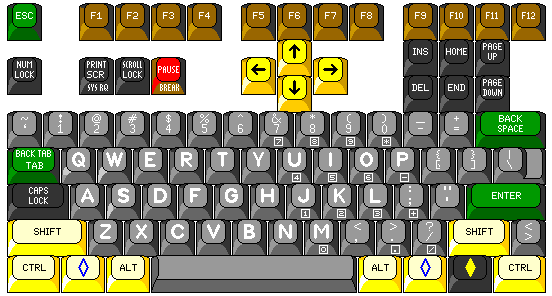
But that may be the wrong direction to go in; since very compact keyboards are popular, instead, by using the Fn key to handle the infrequently used Print Screen, Scroll Lock, and Pause keys, as well as the function keys, one can achieve a large gain of convenience over a design such as the Happy Hacking Keyboard while only adding a single row of keys to the main typing area:
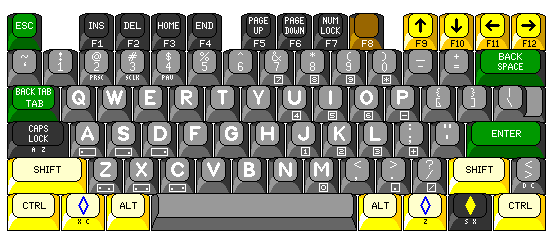
Note that no Fn key, required as a shift key to allow the twelve keys at the top in three groups of four to be used as the function keys (as well as for Print Screen, Scroll Lock, and Pause), is shown on the keyboard.
When Num Lock mode is in effect, this keyboard, like many laptop keyboards, dedicates some of the keys that are used to type letters to forming part of a numeric keypad. As a result, alphabetic typing is not available in that mode. Therefore, the six keys for A, S, D, Z, X, and C are used to switch the keyboard between several default modes of operation. A and Z (or the keys in their positions on a foreign-language layout) are used to select the Caps Lock key as the Fn key; in that mode, the key also used as the F8 function key is normally the Caps Lock key instead. S and X are used to select the Windows Menu key as the Fn key; in that case, the F8 key serves as the Windows Menu key instead. D and C are used to select the international key, the extra printable character key to the left of the left-hand shift key, as the Fn key; in that case, the F8 key serves as the substitute for that key.
As it may be considered more important to have both a left and right hand Fn key than a left and right hand Windows Shift key, if the keys on the bottom row are used to select the Fn key, the Windows Shift key on the opposite side of the keyboard is also used as a second Fn key. Thus, if Z is pressed, the right-hand Windows Shift key becomes the second Fn key; if X or C is pressed, the left-hand Windows Shift key becomes the second Fn key.
It is envisaged that a keyboard like this, intended as competiton to the Happy Hacking Keyboard, would be aimed at serious keyboard enthusiasts. So, while a simple set of six standard layouts are reachable from the initial configuration, it is also expected that once an Fn key is available, there will be a procedure to choose from additional standard layouts, and, indeed, that there will also be available mechanisms to set up arbitrary keyboard layouts. (There is a project afoot to bring out a keyboard based on the main typing area only of a standard keyboard that provides for full re-assignment of keys, the Miniguru keyboard.)
Thus, while the keyboard initially has an extra row of keys on the top, nothing would stop someone from choosing a configuration which uses the Fn key more extensively, avoiding the need to reach that far up, like the following:
--- --------------- --------------- --------------- | | | | | | | | | | | | | | | | | | | | | | | | | | | | | | | | | | |-----------------------------------------------------------| | | | | | | | | | | | | | | | |ESC|F1 |F2 |F3 |F4 |F5 |F6 |F7 |F8 |F9 |F10|F11|F12| | |-----------------------------------------------------------| | | | | |PG | | |CAP|WIN| < | | | | | | | |INS|HOM|UP | | |LK |MNU| > | | | | | |-----------------------------------------------------------| | |NUM| | |PG | | | | | ^ | | | | | | |LK |DEL|END|DN | | |<- | ->| | | v | | | |-----------------------------------------------------------| | | |PRT|SCL|PAU| | | | | | | | | | | |SC |LK | | | | | | | | | | |-----------------------------------------------------------| | | | | | | | | | | | | | | | | | | -----------------------------------------------------------
Note that the three keys that could possibly be reassigned to the F8 key and used as the Fn key all have their own unique equivalents, rather than simply being assigned to one replacement position. (This also allows the possibility of a variation where the Caps Lock key and the Windows Menu key both serve as Fn keys, leaving both Windows Menu keys available, but having an Fn key on both sides of the keyboard. The international key could also be dispensed with, returning to a full-sized right Shift key.)
This arrangement can be compared to the different arrangements of the Happy Hacking Keyboard and the Miniguru which serve a similar purpose.
If the keyboard is designed so that the keys in the positions of the Caps Lock, Tab, and |\ keys can be used as shift keys without causing ghosting, it is even possible to manage with the main typing area of the 101-key keyboard before the Windows keys were added:
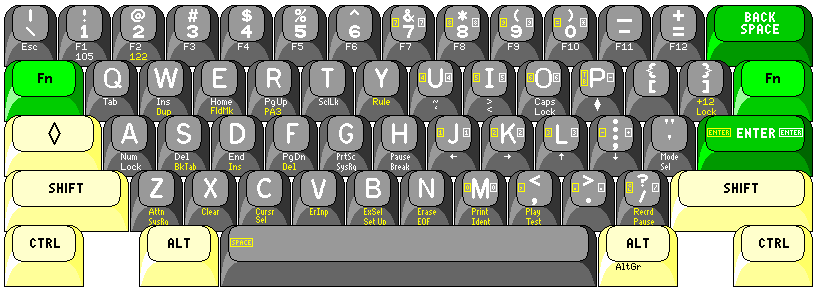
An attempt is made to show how such a limited keyboard could even be made to serve reasonably well for emulating a 122-key keyboard, in addition to a normal computer keyboard with Windows keys. Fn-single quote is "Mode Select", which, followed by 1 or 2 selects the 105-key and 122-key keyboard modes respectively. Fn-right square bracket is "+12 Lock", which is used to shift Fn-1 through Fn-equals from PF1 through PF12 to PF13 through PF24.
The numeric keypad is different between these two keyboard types as well. Thus, space and comma are part of the numeric keypad for the 122-key keyboard. Also, a 122-key keyboard does not need a Num Lock key, since the numeric keypad does not have cursor functions as an alternate purpose of the numeric keypad; but this keyboard, not having an actual numeric keypad, still needs the Num Lock function in order to switch to using some of the keys on the keyboard to operate as the numeric keypad keys.
Thus, the key on the 122-key keyboard in the position of the Num Lock key is shown as CL, and the extra key on the numeric keypad on that keyboard is shown as =, as keys in those positions are the "clear" and "=" keys on the Macintosh keyboard, while normally being blank on the 122-key keyboard.
Thus, the basic keyboard is:
-----------------------------------------------------------
| | | ! | @ | # | $ | % | ^ | & | * | ( | ) | _ | + |BACK |
| \ | 1 | 2 | 3 | 4 | 5 | 6 | 7 | 8 | 9 | 0 | - | = |SPACE |
|-----------------------------------------------------------|
| | | | | | | | | | | | { | } | |
|Fn | Q | W | E | R | T | Y | U | I | O | P | [ | ] |Fn |
|-----------------------------------------------------------|
|WIN | | | | | | | | | | : | " | |
|SHF | A | S | D | F | G | H | J | K | L | ; | ' |ENTER |
|-----------------------------------------------------------|
| | | | | | | | | < | > | ? | |
|SHIFT | Z | X | C | V | B | N | M | , | . | / |SHIFT |
|-----------------------------------------------------------|
| | | | |ALT | | |
|CTRL | |ALT | |AltGr| |CTRL |
----- ---------------------------------- -----
In 122-key mode, it experiences some slight changes:
-----------------------------------------------------------
| } | | | @ | # | $ | % | ¬ | & | * | ( | ) | _ | + |BACK |
| { | 1 | 2 | 3 | 4 | 5 | 6 | 7 | 8 | 9 | 0 | - | = |SPACE |
|-----------------------------------------------------------|
| | | | | | | | | | | | ! | ¦ | |
|Fn | Q | W | E | R | T | Y | U | I | O | P | ¢ | \ |Fn |
|-----------------------------------------------------------|
| | | | | | | | | | | : | " | |
| | A | S | D | F | G | H | J | K | L | ; | ' |RETURN |
|-----------------------------------------------------------|
| | | | | | | | | | | ? | |
|SHIFT | Z | X | C | V | B | N | M | , | . | / |SHIFT |
|-----------------------------------------------------------|
| | | | | | | |
|RESET| |ALT | |ALT | |ENTER|
----- ---------------------------------- -----
Under Fn-shift, in 105-key mode, it becomes:
----------------------------------------------------------- | | | | | | | | | | | | | | | |ESC|F1 |F2 |F3 |F4 |F5 |F6 |F7 |F8 |F9 |F10|F11|F12| | |-----------------------------------------------------------| | | | | |PG |SCL| | ~ | > |CAP|WIN| | | | | |TAB|INS|HOM|UP |LK | | ` | < |LK |MNU| | | | |-----------------------------------------------------------| | |NUM| | |PG |PRT|PAU| | | ^ | | | | | | |LK |DEL|END|DN |SC | |<- | ->| | | v | | | |-----------------------------------------------------------| | | | | | | | | | | | | | | | | | | | | | | | | | | |-----------------------------------------------------------| | | | | | | | | | | | | | | | | ----- ---------------------------------- -----
While in 122-key mode, the Fn-shift meanings of the keys are:
----------------------------------------------------------- | |PF |PF |PF |PF |PF |PF |PF |PF |PF |PF |PF |PF | | | |1 |2 |3 |4 |5 |6 |7 |8 |9 |10 |11 |12 | | |-----------------------------------------------------------| | | |DUP|FMK| | | | ~ | > |CAP| | |+12| | | |TAB|PA1|PA2|PA3| |RUL| ` | < |LK | | |LK | | |-----------------------------------------------------------| | |NUM|BK | | | | | | | ^ | | | | | | |LK |TAB|INS|DEL| | |<- | ->| | | v | | | |-----------------------------------------------------------| | | | | | | | | | | | | | | |F1 |F2 |F3 |F4 |F5 |F6 |F7 |F8 |F9 |F10| | |-----------------------------------------------------------| | | | | | | | | | | | | | | | | ----- ---------------------------------- -----
Although there is no Num Lock key on a 122-key keyboard, the key so labelled is still used to switch this abbreviated keyboard into numeric keypad mode, but now the mode is internal to the keyboard, rather than requiring the participation of the computer, to interpret the same scan codes as numbers rather than cursor controls.
Note that here PF1 through PF24 refer to the function keys above the keyboard, while F1 through F10 refer to the keys to the left of the keyboard which are not labelled that way, but instead have individual functions noted on them, but which differ on different versions of the 122-key terminal emulation keyboard.
As noted above, +12 Lock is used to toggle changing PF1 through PF12 to PF13 through PF24 respectively.
The numeric keypad in 105-key mode is:
----------------------------------------------------------- | | | | | | | | | | | | | | | | | | | | | | | 7 | 8 | 9 | * | | | | |-----------------------------------------------------------| | | | | | | | | | | | | | | | | | | | | | | | 4 | 5 | 6 | - | | | | |-----------------------------------------------------------| | |NUM| | | | | | | | | | | | | |LK | | | | | | 1 | 2 | 3 | + | |ENTER | |-----------------------------------------------------------| | | | | | | | | | | | | | | | | | | | | | 0 | | . | / | | |-----------------------------------------------------------| | | | | | | | | | | | | | | | | ----- ---------------------------------- -----
And the numeric keypad in 122-key mode is:
----------------------------------------------------------- | | | | | | | | | | | | | | | | | | | | | | | 7 | 8 | 9 | = | | | | |-----------------------------------------------------------| | | | | | | | | | | | | | | | | | | | | | | | 4 | 5 | 6 |TAB| | | | |-----------------------------------------------------------| | | | | | | | | | | | | | | | | | | | | | | 1 | 2 | 3 | - | |ENTER | |-----------------------------------------------------------| | | | | | | | | | | | | | | | | | | | | | 0 | , | . |CLR| | |-----------------------------------------------------------| | | | | | | | | | | | |SPACE | | | | ----- ---------------------------------- -----
which is what the legends on the keys in the picture above are intended to convey.
Or, one could simply accept having smaller Control, Alt, and Windows Shift and Menu keys, so as to have fixed explicit Fn keys, and then, by making the Esc key a shifted key as well as the Fn keys, the only key that needs to be reached by the Fn shift within the main body of the keyboard would be the Pause/Break key (here shown as the shift of the Backspace key):
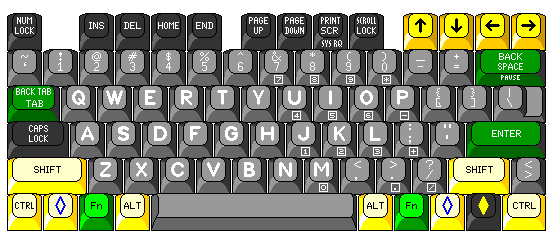
resulting in a keyboard that is even less intimidating.
One could give up the Windows Shift key on the right side to get the wide spacebar of the 101-key design back... and, given that the key in the lower left of the keyboard is so small, the option of swapping the left-hand control key with the Caps Lock key perhaps becomes more desirable, and so:
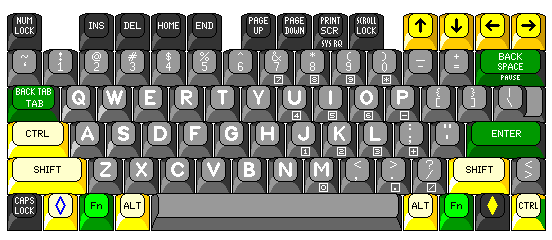
it is shown that way in this diagram.
Combining this type of keyboard
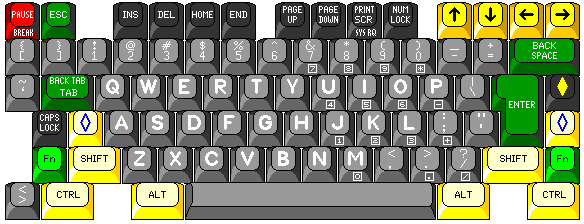
with some of the ideas examined on the previous page, one obtains the arrangement above, where the Windows keys and a pair of function keys are disposed symmetrically. Originally, the ones on the left might have been a bit hard to reach, but then the left-hand shift key was shortened from its original size, as well as the Caps Lock key not only being shortened, but interchanged with the Windows shift key, since hitting the Caps Lock key accidentally is a concern for many.
This style of main keyboard could even be used in a full-size keyboard:

The placement of the {[ and }] keys is only one of the issues, but one of the most serious, that would need to be faced in attempting to make a keyboard, suitable for use with the standard IBM PC platform, that returned the Enter key to the traditional dimensions used with electric typewriters. I have to admit that I despair of any such layout being sufficiently convenient as to have mass appeal, so it would be self-indulgent to attempt to produce one, I fear.
However, in another attempt to improve the design, I came up with this:
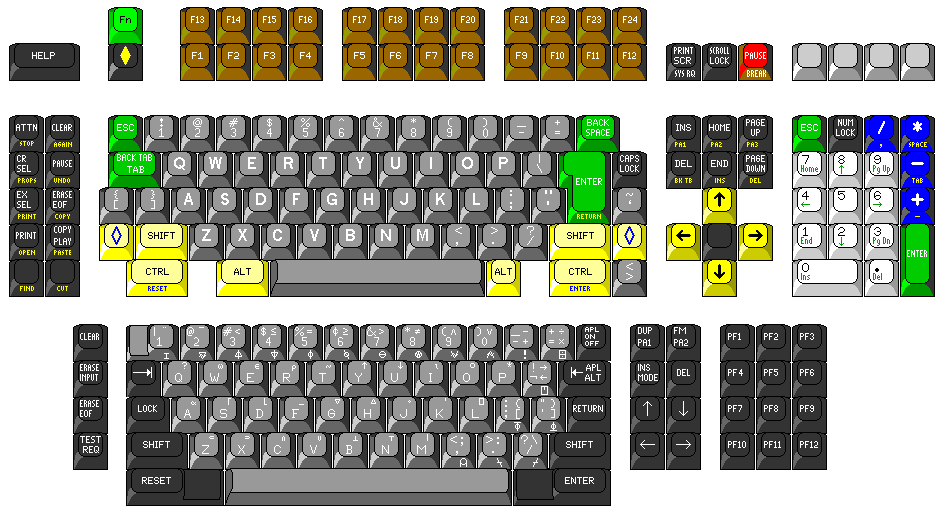
Note that the two Ctrl keys have been moved inwards - to correspond precisely to the positions of the Reset and Enter keys on the Model 3277 Display Station.
The Enter key from the ISO layout has been used rather than one with conventional electric typewriter dimensions, so that the Caps Lock key and the ~` key can be placed to the right of it without widening the keyboard on the right.
Also, the gaps between then and the Alt keys have been reduced to 3/4 the width of a key, rather than exactly one key width. This allows the left-hand Alt key to be widened, to suggest the Code key on some IBM word processing equipment, and for uninterrupted verticals in the spaces between the keys to be avoided, while having the space bar be exactly six key widths long (which is important for availability as a standard part). It still retains, however, the benefit of moving the Windows keys out of the way, by leaving a gap between the Ctrl and Alt keys, leaving that part of the keyboard simpler to minimize the chance of hitting the wrong key.
Copyright (c) 2007, 2009, 2010 John J. G. Savard